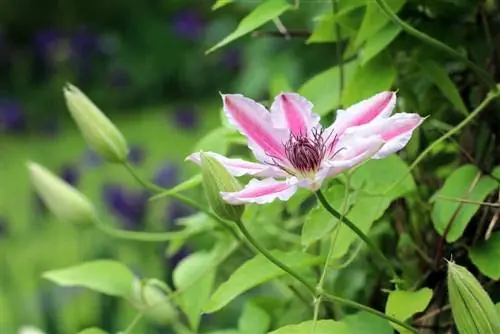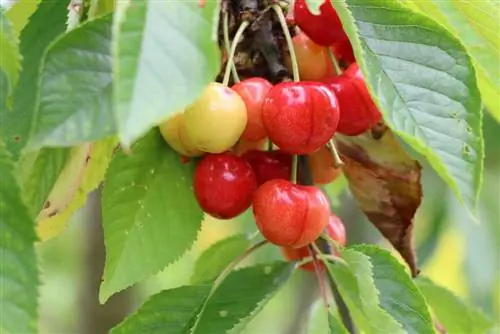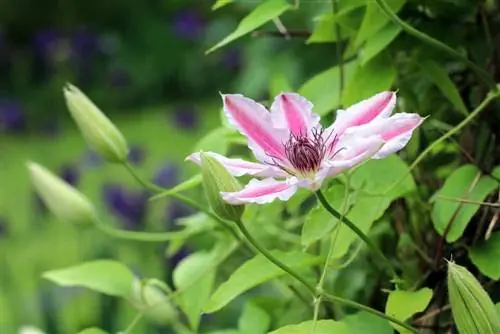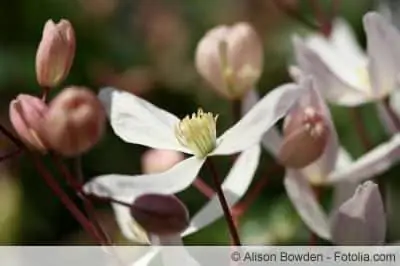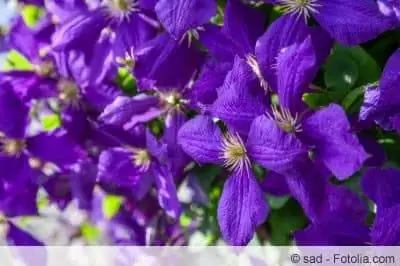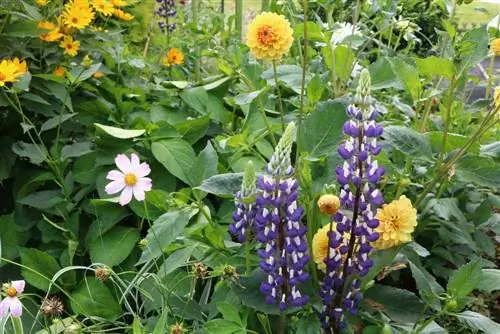- Author admin [email protected].
- Public 2023-12-17 03:39.
- Last modified 2025-01-24 12:45.
'Nelly Moser' is one of the stars in the extensive clematis family. Their rapid growth and rich flower development delight even impatient gardeners every year. Numerous pink petals with a decorative violet-red central stripe stand out in particularly high contrast against the green leaf background. With a few suitable care measures, it will climb high and conquer any trellis. It also gives dull walls a colorful shine.
Growth and flowering
The Clematis 'Nelly Moser' quickly climbs heights of up to 3.50 m with the support of a trellis. House walls and rose trellises also give it the support it needs, because its tendrils are thin and do not provide enough support on their own. Every spring, fresh green leaves sprout and form an opaque work. From May onwards the beautiful flowers appear in almost lavish abundance. Their diameter is between 12 and 15 cm. From August onwards, good care will be rewarded with an encore: a second round of flowers will begin. In autumn the leaves and flowers gradually disappear and the naked, inconspicuous tendrils go into winter.
Location
It can be sunny for lush flower growth, the more the better. The only thing that should be avoided is the blazing midday sun. 'Nelly Moser' is also content with a partially shaded spot. In the shade, growth would be rather stunted and flower formation would suffer. While the above-ground parts of this climbing plant enjoy sun, sun rays are completely undesirable in the root area. When planting, this wish must be fulfilled from the very beginning. There are several solutions available for this, some of which can be combined with each other:
- Ground cover plants intercept the sun's rays
- Mulch layer of 10 cm keeps the roots cool
- Plant the root ball about 10 cm deeper
- Place plant-based neighbors to provide shade
Floor
Two reasons speak for loose soil. First, the clematis' delicate roots don't encounter as much resistance as they grow. In deeply loosened soil, they can quickly penetrate into the deep layers of the earth to find water there, even on warm days. A clematis that can take care of its own water balance saves the gardener a lot of work. Secondly, loose soil allows excess water to seep away more easily. After all, clematis doesn’t like wet roots. Ideally, a few stones should be added to the soil under the bale to prevent waterlogging. In addition, the soil should be nutrient-rich so that the flowers appear in the desired splendor. Incorporated compost ensures that the soil is ideally nourished.
Plants
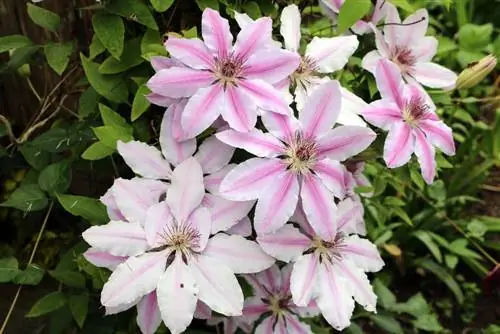
There are two options for freeing the clematis from its cramped quarters after purchasing it: a large bucket or the garden bed. The 'Nelly Moser' is extremely hardy and can comfortably set up outdoors all the time. Once you have found a suitable outdoor location for the clematis, you can plant it out according to the following instructions:
- First provide the bale with plenty of water. It should stand in a bucket of water for at least 20 minutes.
- Dig a planting hole, loosening the soil thoroughly.
- Place a drainage layer of stones in the planting hole.
- Mix the excavated soil with compost to enrich it with nutrients.
- Now you can free the clematis from its old pot without pulling any tendrils. Hold the plant upside down so it can slide out.
- Place the clematis about 10 cm deeper so that the roots are better protected from the sun.
- Fill the gaps with the compost-enriched soil.
- Make a watering wall around the plant and water it.
- Attach a climbing aid straight away, as the clematis grows quickly.
Tip:
Planting out clematis is a good opportunity to preventively protect them against mouse damage. Plant the root ball together with a trellis to keep voles at a safe distance.
Bucket Culture
If you don't have any garden space available, you can make do with a large planter. As a potted plant, the clematis has some demands in terms of pot and care.
- large pot with at least 25 liter volume is a must
- Large holes in the bottom ensure water drainage
- A drainage layer helps against unwanted waterlogging
- high-quality and nutrient-rich soil
- Roots must be protected from sunlight
- stable trellis is required
- beautiful, branched shape is achieved by pruning
- As a container plant, it needs winter quarters without frost
- as a second choice: sheltered location and plenty of fleece
Tip:
The initially nutrient-rich soil becomes depleted over time and should be replaced with new one. After about four years it's time for a fresh environment.
Fertilize
Clematis is a plant that needs to be well supplied with nutrients during the growing season. Only then will it sprout well and produce many flowers. Horn shavings can provide a sufficient supply if they are applied early in the spring. The microorganisms in the soil gradually release the nutrients so that they can be easily absorbed and utilized by the clematis. Rose fertilizer has also proven to work well for clematis and can be used during the flowering period. The fertilization season will be over by August at the latest, as the winter rest period will soon be approaching for the clematis.
Pouring
Over the years, a clematis becomes more and more self-sufficient when it comes to its water balance. Their roots reach deep into the earth, where there is still residual moisture even on dry days. However, additional watering is required from time to time.
- additional watering is required on particularly hot days
- young clematis have not yet formed enough roots
- water more often in the first few years
- moisture evaporates more quickly from the pots
- Potted plants therefore suffer from drought more quickly
- Always water carefully to avoid waterlogging
- It is better to supply smaller amounts of water more often
Cutting

Depending on their growth and flowering behavior, the different clematis require different cuts. Experts have therefore divided the clematis into three groups. The cutting recommendations should be followed so that the clematis develops and blooms well.
- The twice-flowering 'Nelly Moser' belongs to pruning group 2
- slightly cut back to about half
- Autumn is the right time for this cutting measure
- short shoots sprout from the remaining wood in spring
- this is where the flowers are formed
Radical cut
So that the climbing plant does not become bald over time, severe pruning is occasionally necessary.
- every four to five years
- cut back to 20 to 50 cm
- only in the following year the flowers are sparser
The clematis recovers quickly from this radical pruning measure and is already in full bloom in the flowering season after next.
Cutting when wilting
A clematis that finds all the desired conditions is quite resistant to disease. If the dreaded clematis wilt still attacks you, you have to pick up the secateurs quickly.
- first disinfect the cutting tool thoroughly
- cut off all affected parts
- Pick up leaves from the ground too
- Dispose of cut-off items in the trash
- Disinfect the cutting tool again
Note:
However, if the root base is infected by the fungus, the clematis can no longer be helped.
Diseases and pests
A hot summer can bring powdery mildew. To ensure that the damage to the clematis is kept to a minimum, the affected plant should be treated promptly with a suitable agent. An animal danger threatens the roots of the clematis from the voles. They love the roots of this clematis so much that they don't leave much of it left. But without its roots, the clematis cannot survive. If your garden is a playground for these pests, the clematis needs reliable protection. If the roots are protected with a mesh basket when planting, the mice have no chance.
Tip:
Powdery mildew can still be easily controlled naturally in the initial phase, as long as the spread has not progressed too far. A mixture of one part whole milk and eight parts water works well for spraying the plant.
Overwintering outdoors
In autumn, 'Nelly Moser' strips her vines and begins her well-deserved rest. It is extremely hardy and requires little help.
- a covering made of fir branches keeps out icy wind
- Mulch layer provides some warmth
- freshly planted clematis are not yet sufficiently hardy
- It is essential to protect young clematis in the first few years
- full-grown clematis are more resistant to cold
Overwintering potted plants
Potted plants should not spend the winter outside, even if the clematis growing inside is considered hardy. In the pot, the roots are not well protected against frost.
- a bright and cool room is ideal for winter
- Bring in clematis before the first frosts
- from mid-May the bucket can be taken out again
- alternatively, the clematis can overwinter outside
- The location should be protected from the wind
- Wrap the plant and pot with plenty of fleece
- Fleece can be removed again from May

